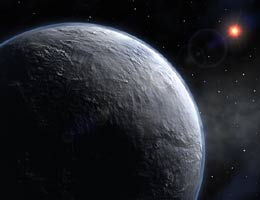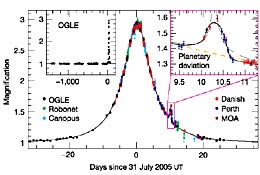
Astronomers have no direct information about the composition of the newly discovered exoplanet OGLE-2005-BLG-390Lb. But based on its low temperature and its mass, the planet probably consists mostly of ice and rock with a thin atmosphere. This artist's rendering depicts the planet as an overgrown version of Pluto. Click on the image for a larger view.
Courtesy European Southern Observatory.
Three international groups have teamed up to discover what is probably the lowest-mass exoplanet ever found around a normal star. The planet's mass is between 3 and 11 times that of Earth, with a most likely mass of 5.5 Earths. The previous record-holder, which orbits the red-dwarf star Gliese 876, contains about 7.5 Earth masses. The only known exoplanets with lower masses are four objects orbiting a pulsar — the collapsed core of a massive star that went supernova.
The newfound planet was the third exoplanet discovered by gravitational microlensing — an effect predicted by Einstein's general theory of relativity that occurs when two objects line up almost perfectly with Earth. In this case, a foreground red-dwarf star passed in front of a background star and acted as a gravitational lens. The red dwarf's gravity redirected some of the background star's light toward Earth, causing the background star to brighten threefold and then fade over the course of 1½ months. A planet orbiting the red dwarf acted like a secondary lens, causing a slight additional brightening and fading that lasted about 30 hours.
The OGLE group, which is led by Andrzej Udalski (Warsaw University Observatory, Poland), first noticed the brightening of the background star on July 11, 2005. OGLE alerted two other groups, PLANET and MOA, and all three began monitoring the star continuously with telescopes around the world. They detected a characteristic brightening that peaked on July 31st. As the background star was fading on August 9th, the teams observed a 30-hour brightening and fading caused by the planet, which has been named OGLE-2005-BLG-390Lb. The PLANET group, led by Jean-Philippe Beaulieu (Paris Astrophysical Institute), made the most sensitive and critical observations on August 9th and 10th.

This light curve combines photometry data from three different groups. It shows a background star brightening until it reached a peak on July 31, 2005. This brightening was caused by the gravitational lensing effect of an intervening star. About 10 days later, the background star suddenly brightened and faded over the course of 30 hours, due to the gravity of a low-mass planet in orbit around the lensing star. Click on the image to view a larger version.
Courtesy Jean-Philippe Beaulieu, et al. / Nature.
"This planet is pretty clearly real. It's seen in multiple datasets from multiple observatories," says Scott Gaudi (Harvard-Smithsonian Center for Astrophysics), who studies gravitational microlensing but was not involved in the discovery.
Unfortunately, the microlensing method detects the host star and planet only through their gravity. About all that can be said right now is that the system is roughly 22,000 light-years away in the direction of the galactic center, the planet lies roughly 2.6 astronomical units from the star (which would put it in the asteroid belt in our solar system), and it probably takes about 10 years to complete one orbit. Since the star radiates only about 1 percent the energy of the Sun, the planet must have a surface temperature of about –220°C (–364°F), which is almost certainly way too cold for life.
"While the other two microlensing planets have masses of a few times that of Jupiter, the discovery of a 5-Earth-mass planet — though much harder to detect than more massive ones — is a strong hint that these lower-mass objects are very common," says Beaulieu.
"If Jupiter-like planets were as widespread, the microlensing method should have found dozens of them by now," adds PLANET team member David Bennett (University of Notre Dame). This discovery probably means that low-mass stars like red dwarfs generally have lower-mass planets than stars like the Sun. This conclusion falls perfectly in line with predictions of theorists who model planetary formation.
Microlensing is the only current technique that can find Earth-mass planets. "The strength of microlensing is not finding planets that you can go study," says Gaudi. "The strength of microlensing is that it allows astronomers to get statistics of planetary systems, and allows us to detect planets that we would never have been able to detect otherwise. It tells you something about the frequency of planets."
The discovery paper is published in the January 26th issue of Nature. The three microlensing teams include a total of 73 astronomers working in 12 nations. The previous exoplanet discovery using microlensing involved the direct participation of amateur astronomers in New Zealand. This discovery, however, was made entirely with professional data. But as Gaudi notes, "This event could have been monitored by amateurs; it was fairly bright."
 0
0
Comments
You must be logged in to post a comment.